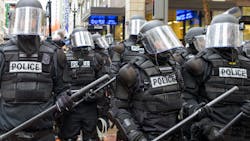As with anything else requiring equipment, both in law enforcement and any other field, evolution occurs. Changes in engineering, the creation of new materials, studies of past events, successes, failures and more… all of this has an impact on how designs change for any and every piece of equipment we use. The easiest example to cite is the evolution of the baton: from wood to polycarbonate to the attachment of a side handle to collapsible/expandable aluminum or steel. We’ve gone from a tool that was sometimes forgotten when an officer got out of his patrol vehicle to one that is always on the belt, weighs less than the older tool did and incorporates both psychological and physical impacts when used. Riot Control gear, or that equipment designed to protect officers when they respond to a riot situation, isn’t any different. It has evolved as well and it’s a mistake not to update yours, especially if you’re waiting to do so when what you currently have fails or becomes unserviceable.
This article appeared in the March/April issue of OFFICER Magazine. Click Here to subscribe to OFFICER Magazine.
When considering your riot control gear, understand that it isn’t just shields and batons, or even helmets and face shields. In today’s world, an agency’s riot control gear list should include all of that but also protective masks, a variety of types of body armor, gloves, gauntlets and every less-lethal tool in your response truck(s). We would submit to you that if your gear is more than ten years old, even though it still seems serviceable, it either needs to be replaced or, at a minimum, it needs to be inspected by the manufacturer to insure that it has no defects and continues to perform 100% as it was designed to.
Let’s take a quick look at shields and what’s available. Riot Control shields didn’t used to have the option of incorporating any ballistic protection. They used to simply be clear plastic (or other synthetic) material designed to deflect thrust or thrown weapons such as bottles, bricks, etc. While the majority of today’s riot control shields don’t incorporate ballistic protection, the clear materials used allow them to be lighter and easier to hold for longer periods of time. Training in their use has also evolved so that their deployment isn’t only defensive but can also incorporate using them as less- or non-lethal impact tools. Some of today’s ballistic shields, thanks to built in viewing ports, lights, better carrying handles and lighter weight materials, can be used as riot control shields. The ballistic shields offer better protection from a wider range of threats and can still be used as less- or non-lethal impact tools. In general, they are heavier than the riot control shields.
Riot control batons are generally polycarbonate, nylon, aluminum or other synthetic material now. Some have been designed to integrate an electronic “stun” capability, but we’ve not seen many of such in use. They generally aren’t long enough to perform the primary function of keeping rioters at more than arm’s length from the officers.
Helmets and face shields have also evolved although it seems like the 1970s style still seems to be in many agencies’ inventory. Materials have evolved quite a bit in the past 50 years and if your agency hasn’t updated its riot control helmets, you really need to. Add to that the need to update gloves, make sure that your officers’ boots have the proper design features for such work and consider investing in more chest plates, back plates, and arm and leg guards. At the end of the day, it’s all about keeping your officers protected in the best way contemporary technology permits.
This article appeared in the March/April issue of OFFICER Magazine

Lt. Frank Borelli (ret), Editorial Director | Editorial Director
Lt. Frank Borelli is the Editorial Director for the Officer Media Group. Frank brings 20+ years of writing and editing experience in addition to 40 years of law enforcement operations, administration and training experience to the team.
Frank has had numerous books published which are available on Amazon.com, BarnesAndNoble.com, and other major retail outlets.
If you have any comments or questions, you can contact him via email at [email protected].



